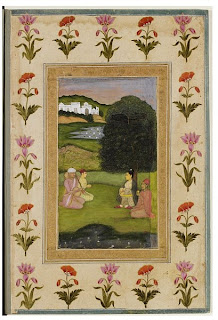Shamsa (rosette) with name and titles of Emperor Shah Jahan, Mughal, 17th c, India.
This shamsa is an exquisite example of the art of illumination in the Mughal period. The profusion and gem-like detail of the floral decoration of the rosette, set along scrolling vines, can be traced to the illumination of the late Timurid period. Known as the international Timurid style, this style features veritable gardens of flowers in its illumination. It spread as far as Ottoman lands, epitomized by the sukufe floral style of Ottoman illumination. Gold and lapis lazuli are used to rich effect here, also echoing earlier Timurid and Safavid illumination techniques.
Under Jahangir and his successor, Shah Jahan, the number of manuscripts produced by the imperial atelier was greatly reduced, resulting in fewer, and generally more elaborate, designs and manuscripts such as this.
|












































No comments:
Post a Comment